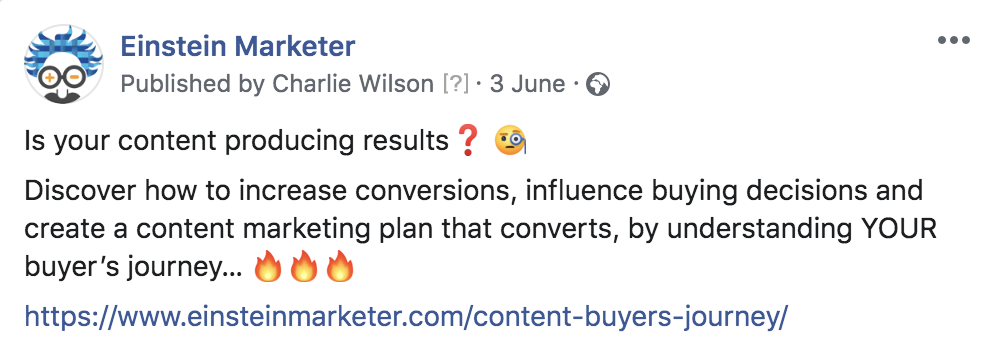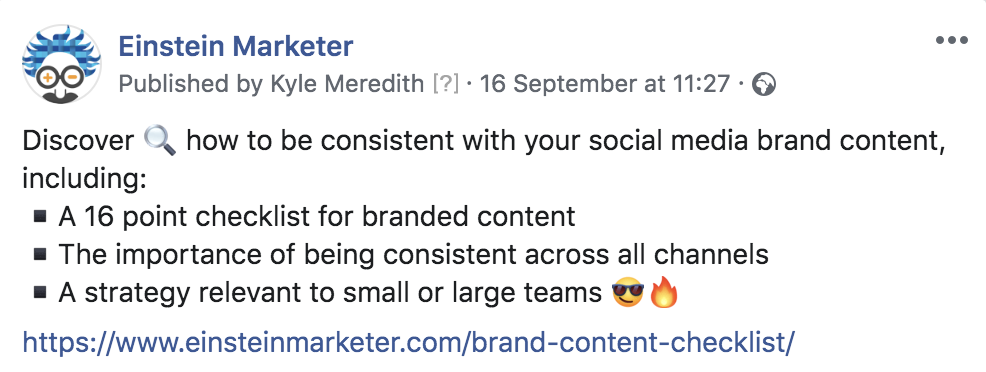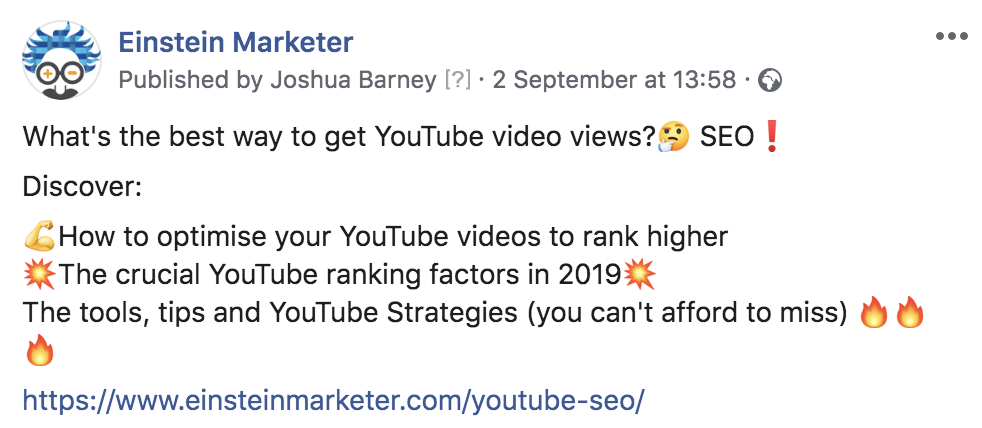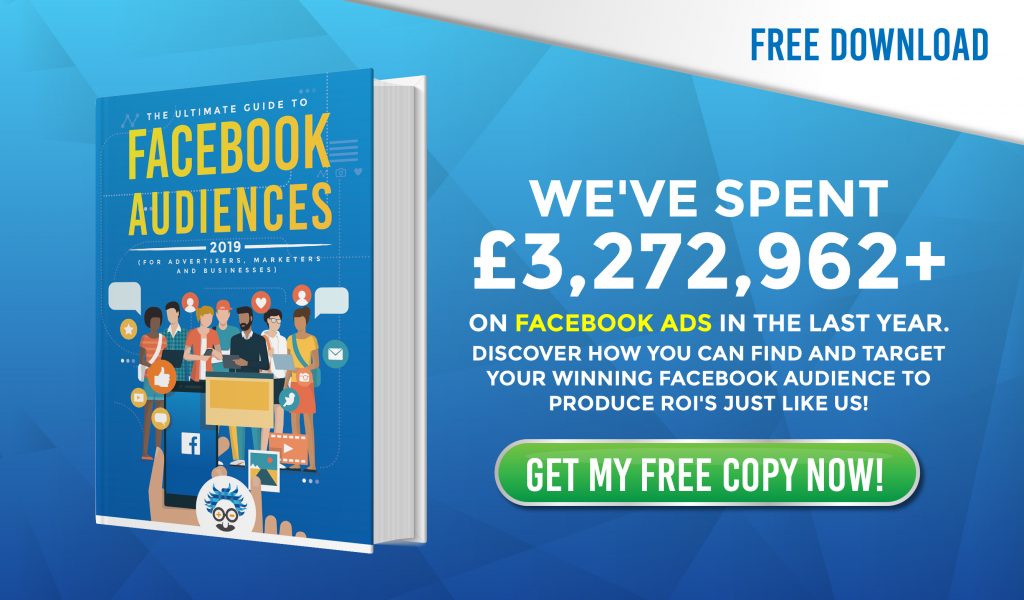It’s easy to slip into a routine, especially in digital marketing.
A typical process for content and social media promotion, tends to look a little like this:
- Create
- Publish
- Distribute
And the more often you go through this three-step process, the easier it is to slip into a routine and lose focus on tracking, testing and optimising.
The reason I say this, is because over a 6-week period in the summer, our Facebook engagement rate dropped.
Before this ‘dry spell’ our typical post engagement rate was at approximately 10%, which isn’t bad, especially when you consider that our entire Facebook posting strategy was to promote blog posts (and our audience was 50k followers).

BTW: It’s much more difficult to generate engagement when your post’s value is away from the platform (like an external article or blog post).
But during June and July, our Facebook post engagement dropped to as low as 3-5% (as an average).

Contents
To Win, Somebody Has To Lose
I accept that every post I create isn’t going to break records, do better than the last or be a smash hit with our audience.
So when a post does badly, I put it down as a learning experience.
But when there is a consistent downturn in results, you simply cannot avoid it, put it off or blame the time of year.
I spoke to some other marketers about these results and they blamed the season, saying that summer is a tough period for marketing content.
However, I will never blame an external force for results on my own content. [click_to_tweet tweet=”When a social network changes their algorithm, penalises certain content, restricts reach or negatively affects business pages, it’s not a game ender, it’s a game CHANGER.” quote=”When a social network changes their algorithm, penalises certain content, restricts reach or negatively affects business pages, it’s not a game ender, it’s a game CHANGER.” theme=”style3″]
And nobody is more excited (and prepared) to adapt, find new winning tactics and get ahead.
Why Did Our Facebook Engagement Rate Drop?
To properly understand what happened I had to analyse our three-step process (mentioned at the start of this article) for posting content on Facebook:
-
Create
The first thing I did was to go back over our content, comparing our historic posts (that had generated high engagement levels) to our new content (that was performing poorly for engagement).
BTW: You can discover your post’s engagement rate in the ‘Insights’ tab on your Facebook Business Page. Follow these steps:



I spent some serious time going over everything; topic, angle, category, headline and most importantly, analysing the needs of our target market…
…and I didn’t find a lot wrong.
Sure, it’s easy for me to look at our agency’s own content through rose-tinted glasses, but after a serious spell of self-critiquing and speaking to our regular readers…
…I couldn’t find a drop in quality. In fact, the majority of people I spoke to actually said the posts were better.
I knew ‘creation’ wasn’t the problem and moved my analysis onto the other steps of our process.
-
Distribute
Our engagement rates hadn’t dropped on any other channel or medium, other than Facebook.
So, it would’ve been a waste of my time and energy to measure every channel or look at our distribution strategy AWAY from Facebook.
Our Facebook distribution tactics weren’t any different to when we were generating high engagement levels, but in an effort to leave no stone unturned, I dived in anyway.

(VERY IMPORTANT!!!) This is what we were doing on FB:
- Sharing our FB posts to relevant groups (without spamming anyone)
- Tagging mentioned/contributing businesses and individuals
- Never publishing more than one post per day (very important for reach on FB)
- Running our content posts on a small budget as a Facebook ad
I analysed each of these steps and discovered that we hadn’t lost any engagement from sharing our posts to relevant groups, tagging other accounts, or publishing more than one post per day.
This left me with one option, our Facebook ads. I needed to talk to our team of media buyers.

We discussed our audience targeting, campaign objectives, ad budget and post reach, before I went away and analysed everything myself…
…and I couldn’t find a problem.
We were doing what we had before, testing, tracking and optimising our audiences, on the campaign objective that we had always used, and we were reaching a similar audience size, on the exact same budget.
I came to the conclusion that distribution was (almost definitely) not the problem and moved my Facebook engagement rate analysis onto the third and final step in our Facebook marketing process.
-
Publish
Bearing in mind that I was happy with the content (creation) and satisfied that distribution wasn’t the cause of our dip in Facebook engagement, I was left with (the quickest and most straight-forward steps) publishing content.
To help me understand what had gone wrong, I analysed several posts that had performed very well just a month (or so) before (their engagement rate was between 13-18% on all posts)…
…with some that had performed terribly at the time (2-3% engagement rate).
Before we go any further, can you guess which of these two posts generated 17% engagement and which gained just 2%:


Guessed it?
The first post (Instagram Story Ideas) is the one that generated just 2% engagement on Facebook, and the other (How to Find Keywords...) received an engagement rate 8.5x higher (17%).
But why?
The first thing that’s noticeable is the image.
The Instagram article post is brighter, stands out more on a newsfeed and includes the Instagram logo, which was (and still is) an incredibly hot topic in the world of marketing.
(So I knew the image wasn’t the problem).
The next thing that’s noticeable are the headlines, the Insta post includes a number, whilst the other doesn’t. This statistic actually goes against all our other posting data… [click_to_tweet tweet=”…posts with numbers tend to perform better (especially on social) than those without.” quote=”…posts with numbers tend to perform better (especially on social) than those without.” theme=”style3″]
So, the headline wasn’t the answer.
This left me with one really NOTICEABLE problem…
…the copy!
I couldn’t see too much difference in the quality of the copy, so I went back through all our historic posts and discovered something shocking…
…we hadn’t changed the format or style of the copy on our Facebook posts EVER!



We had always used a formula of questions, promises and pain points for our Facebook copy. It had worked initially, but it was clear that it needed updating and testing.
BTW: Check out our Complete Guide to Facebook Ad Creatives and Copy to discover how to build winning ads (including an awesome FB ad copy template)
At this point I wasn’t entirely sure that the copy was the problem, but it was the one thing that stood out, so I decided that it would be the first thing I’d test.

BTW: When you’re running tests to find your optimum post formula, make sure you only test one element at a time. This allows you to find a winner before testing another element.
Facebook Engagement Rate Analysis
I always write the copy for our articles on Facebook. This is because I manage and direct the strategy and content on our website, and I go over everything that is published on Einstein Marketer.
I accepted (ahead of time) that if the copy was the reason that our Facebook engagement rate had taken a nose-dive, I was the one to blame. [click_to_tweet tweet=”There’s little room for stubbornness in marketing. Times change, things need updating and people become blind (or sick of) old tactics, even if they had worked well previously.” quote=”There’s little room for stubbornness in marketing. Times change, things need updating and people become blind (or sick of) old tactics, even if they had worked well previously.” theme=”style3″]
I went back to the drawing board and considered a new copy tactic for our Facebook posts.
BTW: The smallest details can make the biggest difference on digital.
My first port-of-call was our competitors’ posts.
I scanned, scrolled and analysed (what felt like) hundreds of different marketing article posts and kept seeing the same thing…
…their post copy formula was pretty much identical to ours!

This analysis made me certain, writing a different style of copy would differentiate us from other content on Facebook and take our engagement rate back to where it belonged.
Testing and Optimising Copy for Facebook Engagement
Before doing anything, I thought about our audience. After all, the vast majority weren’t visiting Facebook to find and read our articles.
If they wanted to, they could’ve visited our website directly or made a Google search to find the answers to their marketing problem.
So, what change could I make to our posts that would encourage users to click, like, share or comment on our posts?
The answer wasn’t an overhaul, in fact the solution was actual
Want ly staring me in the face the whole time…
…make the copy instantly more consumable!
People engage with posts on social media for a whole host of reasons, but some of the top reasons they share (which is the most valuable of all the engagement metrics) are:
- To bring valuable content to others (entertaining or engaging)
- To define themselves to others
- To grow and nourish relationships
- Enjoying having others engage
BTW: I’ve written an entire blog about Reasons People Share on Social, Check it out!
With this knowledge under my belt, I simply changed the format of our copy from a paragraph of questions, promises and pain points, to bullet-points…

…this instantly transformed our post copy from a block of text, to a bullet-point list with instantly recognisable keywords and solutions!
BTW: We were already using this tactic on other FB ads (for our clients), but had never tried it on our own content.
Users who would normally scroll away (instead of reading through the copy), could be caught and their attention captured in a split second.

And it worked!
In fact, I’ve been using this copy tactic on our Facebook posts since the end of July and it has increased our average by more than 400% (compared to our 6-week dip).

What Can You Take-Away?
There are several things you can learn from this drastic turn around in our Facebook engagement rate.
The first is obviously to track and analyse on every channel. Winning tactics can quickly become losers, especially when competitors use the same (or very similar) tactics.
Audiences get exhausted and tired of seeing the same thing over and over again. You need to stay on top of everything and never let your focus drop.

The second lesson is to go through absolutely everything when you notice a problem. Tiny stages in your process (that you perform on autopilot) can make a massive difference to your results. Nothing should be overlooked.
In this story of our Facebook engagement rate, the only change I made was to use bullet-points instead of a paragraph (and edit our copy according to this format edit).

Thirdly, try using bullet-points in your ad/post copy. However, if you ARE using bullet-points, analyse your competitors and see if they’re doing the same. If they are, what can you do to differentiate your ads?
The problem won’t always lie in your copy, but it’s up to you to perform a thorough audit and discover where it is and why your audience have stopped engaging.

Finally, this isn’t the end of our journey to increase our Facebook engagement rate. I will keep testing (and encourage the other members of our social/media buying team) to do the same on everything (for us and our clients).
I know that sooner or later, our copy, images, headlines or FB posting strategy will need to be updated, and I’ll be excited to find a solution again.
Conclusion
The world of digital is constantly changing. You must be adaptive and dynamic to stay ahead of the competition.
When you find a problem, it’s up to you to find a solution, even if your tactics had generated amazing results previously.
Testing, analysing and optimising is one of the most exciting elements of marketing on social media, particularly when you find a winner…
….that boosts your results by as much as 400%!
Want more Social Media Marketing strategies, tactics and tips?
- Facebook Page Likes: How To Get 1,000’s for FREE
- How to Use Instagram Hashtags (and How Not to) in 2019
- The 3 Big Mistakes (You’re Making) That Are Killing Your Organic Reach on Facebook
- Author Details







7 Responses
You mention both posts were down, but the one with the number 13 was way down. It is a know fact some people will avoid anything to do with this number. Some people refuse to get out of bed on Friday the 13th. If the 13th is near a date I want to fly. That date is always a lot cheaper than the day before or after. Even with bullet points you still need to choose a 12 or 14, because there are a lot of people who are superstitious. I will fly the 13th if it is cheaper.
Love this analysis you did on your own Facebook page. I am always looking at ways to change things when up when they often get stale on social media. Thank you! I will try this tactic as it is hard to get the engagement up without ads today on Facebook.
It can be hard month after month when results have to compete with a great 28 days prior than the current one too.
Thank you Lisa. Good luck with your FB posts!
Really useful stuff as always! Love the Einstein Marketer blog!
Thanks Fiona!
Small changes can make a big difference. I will definitely try bullet-points after reading this. Thanks for sharing this insight with us Josh
Good luck Kristian!